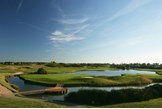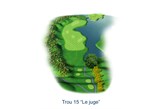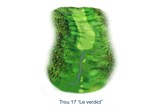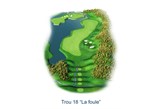Ryder Cup 2018: How difficult IS Le Golf National?
Published: Last updated:
It’s going to take brains and brawn to overcome this year’s Ryder Cup course. We played it to find out how just how tough it will be
If golf courses were fit to feature in the Louvre, Le National’s Albatros course would take pride of place among the Raphaels and Da Vincis.
Situated 20 miles south west of Paris, the par-71 layout looks and plays like a classical combination of an Open and US Open venue and takes inspiration from TPC Sawgrass, so there’s no shortage of water. Not very links-like, we grant you, which might be why Pascal Grizot, the President of Ryder Cup France 2018, likens it to Bethpage Black.
Just don’t be fooled into thinking it’s a bomber’s course. There are no driveable par 4s, and any reachable par 5s are armoured by a throng of sand traps, super-slick greens and fierce undulations. Man-made hills and dunes add to the challenge and amphitheatre, and provide a perfect viewing platform for spectators. Not to mention a hunting ground for lost balls.
Bethpage warns its visitors to “tee it up at your own risk”. Le National doesn’t offer the same courtesy; it just gives you a lesson by emptying out half the contents of your golf bag.
The opening hole sets the nerves jangling from the get-go, and is about as gentle as being smacked in the face by Anthony Joshua. A blind tee shot plays to a narrow green ribbon, flanked by mounds on the right and a lake on the left. The water comes into play again with the approach shot, which plays to a newly-shortened green sandwiched by hazards.
It doesn’t get any easier on the next: a 210-yard par 3, back over the same lake which is kindly accompanied by an over-used drop zone. It’s a tough test for a battle-hardened Tour pro, let alone a mid handicapper. The 7,247-yard layout turns away from water after the par-5 3rd, but not before target golf converges into the first of many risk and reward opportunities.
It’s a battle of wits versus brawn – the perfect cocktail for match play golf. The back nine is where the drama really turns up a notch, with water coming into play on six of the holes. The real test is reserved for the last four holes, which Jon Rahm describes as the “best finishing stretch” in golf. Former Ryder Cup captain Paul McGinley concurs and predicts that they are “going to create incredible drama”.
The 15th and 18th pack the biggest punches and are home to island greens which are responsible for many watery graves. Martin Kaymer sums it up perfectly: “You can attack or you can play defensive, and you can make everything from birdies to doubles, even triple bogeys.” The average golfer would probably settle for the latter, but then we are cut from a different cloth compared to golf’s greatest artists. And you can guarantee Rory and DJ won’t be holding back when the Ryder Cup comes to town.
Course facts
Opened: 1990
Designers: Hubert Chesneau and Robert Von Hagge
Length: 7,247 yards
Par: 71
What’s changed
L’Albatros course underwent a €10 million revamp last year, which saw 17 bunkers, four back tees and two lakes built for the Ryder Cup. The greens on the first and 16th holes have also been redesigned to locate more pin placements, while the par-3 11th has been remodelled to include new bunkering and a pond in front of the green.
The holes where the Ryder Cup will be won and lost
The 15th: Par 4, 408 yards
How it plays: The clue is in its name. ‘Le Judge’ may not be the longest, but precision is a must. A lake snakes around the fairway before wrapping itself around an island green. Opting for a long iron off the tee is the sensible play, and will leave a mid-iron to a green measuring 39 yards front to back.

The 16th: Par 3, 177 yards
How it plays: Modified in 2016, L’Appel is the shortest par 3 on the course and plays downhill to a green framed by bunkers, mounds and water. The biggest danger lurks to the right where the undulations drag balls towards the lake. Miss the green and it will take a minor miracle to keep a bogey or worse off your card.

The 17th: Par 4, 480 yards
How it plays: Twinned with the 18th which plays in the opposite direction, this beastly par 4 appears fairly innocuous at first with no bunkers or water in sight. The tee shot, though straightforward, plays uphill to a fairway filled with humps and bumps. The undulations are just as pronounced on the green, which cambers dramatically from right to left. Ian Poulter told us: “You get a breather from the water on 17 with a long par 4 uphill, slight dog- leg right-to-left. There’s no bunkers on the hole but it’s very, very tough.”

The 18th: Par 4, 471 yards
How it plays: Not for those of a nervous disposition. The final hole was ranked as the hardest at the 2017 French Open and is as dramatic as it is devilish. The design takes inspiration from the 17th at TPC, with the green floating on its own island. Getting the tee shot away is no easy feat, with water on the left and four pot bunkers on the right. After that, good luck! Poulter said: “You have a bit of everything on the last. Bunkers down the right, a water hazard to the left and an island green there to finish. It’s a very good test.”

What the players say
Jon Rahm: “It’s a great design; challenging in every aspect. You do hit almost every single club in the bag. When you miss the green, you have many opportunities. It leaves a lot more to the imagination, especially around the greens. I can’t think of anything bad to say about the course. It doesn’t get boring. I can’t hit driver on every hole because I’m going to be in deep trouble. Being able to hit 5-woods, 3-irons off the tee makes it fun.”
Martin Kaymer: “You need to drive it well. If you hit the fairways, you should create chances. You just need to keep the ball in play. You know par is a good score on 60/70 per cent of the holes.”
Thomas Pieters: “It’s a second-shot course. If you can just place it in the fairway; you don’t need to be very long. But if you don’t hit the fairway, you’re looking at bogey or worse.”
Rory Mcilroy: “If you start to hit it off-line, it really does punish you. There’s a few holes where you have to be conservative and try to take your pars. I think you can be a little aggressive on the par 5s. And those last four holes will bring quite a lot of excitement.”





